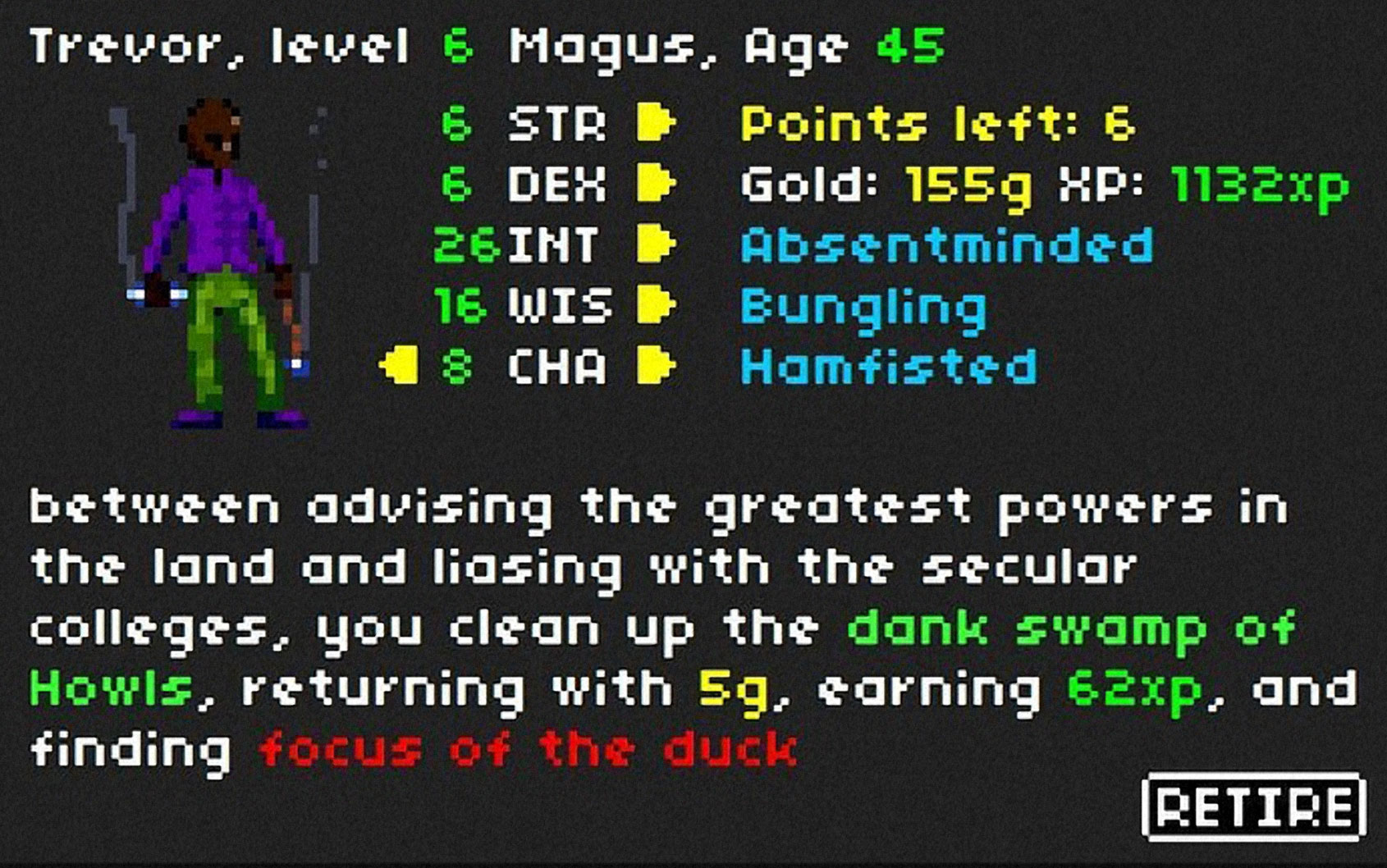
Hey, it's new to me! And after a decade living in the U.S. northeast, I feel like I've come to appreciate how it captures Baltimore's unique spirit. [via]

Hey, it's new to me! And after a decade living in the U.S. northeast, I feel like I've come to appreciate how it captures Baltimore's unique spirit. [via]

@matttomic's Sandwich Alignment Chart isn't just an amusing and thought-provoking taxonomy of sandwiches (though it certainly is that!). (more…)


It starts off innocently. A Wisconsin woman texts her daughter, Jess: "Hunny please grab milk and lunch meet on your way home." But she accidentally sent the text to a 35-year-old man, who was innocently relaxing at home with his wife on his day off. He replied, "I'm pretty sure you have the wrong number. I'm already at home." But the woman didn't believe him. She told "Jess" to "stop playing." The man tried very hard to convince the woman that he was not her daughter, even offering photographic proof. This only made the woman angrier. When she finally realized the man was telling her the truth, she got furious with him and blamed him for tricking her. When he said he was going to post screenshots of the exchange she said, "Post it after u watch your porn u sick pos... do you treat your mother like this?" He replied, "My mom knows my phone number..."














 Hex Kit comes with some old school tiles, and I made this map while I was making sure they worked. These classic tiles come with coasts and stuff just like the new school tiles, but they are much more in the style of the oldest of hex maps: black & white, centered icons, etc. They’re still hand drawn with my own mits though. Classic black & white tiles are the tiles that come bundled with the app, out of the gate. Click here to get the map and have fun, just don’t use it commercially.
Hex Kit comes with some old school tiles, and I made this map while I was making sure they worked. These classic tiles come with coasts and stuff just like the new school tiles, but they are much more in the style of the oldest of hex maps: black & white, centered icons, etc. They’re still hand drawn with my own mits though. Classic black & white tiles are the tiles that come bundled with the app, out of the gate. Click here to get the map and have fun, just don’t use it commercially.

It's easy to squeeze the juice out of a Juicero juice bag with your bare hands. But for some reason, the $400 Juicero machine was built to squeeze charcoal briquettes into diamonds. Ben Einstein, a product designer and venture capitalist, took one apart to see what was inside.
Excerpts:
- Juicero’s Press is an incredibly complicated piece of engineering. Of the hundreds of consumer products I’ve taken apart over the years, this is easily among the top 5% on the complexity scale.
- Because the door must transmit the force of the entire drivetrain pushing against the juice packs, we see MASSIVE machined aluminum components.
- It is exceptionally rare to see a custom power supply on a first-time hardware startup’s product as these are inspected very carefully as part of UL/ETL certification, creating additional cost and risk.
- Like many of the other systems on this product, the motor is seemingly custom to account for the exceptionally high rated power (stalls at 5A at 330V DC, which is hard to believe, possibly even a misprint on the motor casing) and sports a custom encoder system designed by Juicero (yellow arrow)
- Removing the sheet metal frame sheds light on a few more custom-machined aluminum drivetrain components. The number, size, complexity and accuracy of these parts is somewhat mind-blowing for a young hardware startup.
At least the engineers had fun designing this!

We’ve all seen footage of giant factory robots hoisting and placing heavy parts with perfect precision, so it should come as no surprise that a robot arm can adeptly play the knife game without lopping off someone’s finger. But even with that in mind, you’ll still be stressed watching this stabby robot in action.
 |
| This boat battle had 4-5 different mini scenes going on at once involving 8 players, it was awesome |
 |
| There may be a time when you say "there are too many characters" and you will probably be right. |
 |
| You can do it! I believe in you! |

Eddy Gun is a tortoise keeper and a few weeks ago he shared this adorable video of his son feeding the family’s tortoise collection:
https://www.instagram.com/p/BQ9hGinllE2/You can see a few more tortoise videos below and even more photos and videos on Gun’s Instagram.
https://www.instagram.com/p/BQrPJk2FDfT/ https://www.instagram.com/p/BSUtNWFlK_M/ https://www.instagram.com/p/BQZXJpbgxUN/
Kicked off by a post from The Watcher, the RPG.Net forums made The Only Sci Fi Star Chart You'll Ever Need—a cartographic compendium of common space opera tropes.
I'll start the ball rolling by listing a few potential areas and features:
The Diverse Alliance of Nice Guys (or should it be The Nice Alliance of Diverse Guys?)
Proud Warrior Empire
Space Nazi Territory
Star Faring Rome
The Do Not Cross Zone
Elves With Starships
Casablanca Station
Ancient Space Gods' Lawn
Pleasure World
Starship Graveyard
Hostile Robot Hordes
Anomaly #12

After Colin Dickey wrote about United CEO Oscar Munoz's nonpology for the savage beating of Dr David Dao, he was taken to task for accusing the CEO of writing in the "passive voice."
The closer Dickey looked, the more he concluded that "passive voice" is not a good characterization of the style employed by corporate America; rather, the instantly recognizable "Bureaucratic Style" "makes use of both active and passive constructions, but its purpose is uniform: to erase and efface any active agent on the part of the bureaucracy."
Dickey's essay on Bureaucratic Style is fascinating.
To begin with, the bureaucratic style works to erase cause. Here is Munoz’s description of the start of the incident: “On Sunday, April 9, after United Express Flight 3411 was fully boarded, United’s gate agents were approached by crewmembers that were told they needed to board the flight.” Setting aside the passengers for a second, in this sentence there are two named actors: the gate agents and the crewmembers. You might expect, then, that this all started when the crewmembers approached the gate agents and told them they needed to board the flight. However, a closer reading of the syntax implies this is not the case; the crewmembers themselves “were told they needed to board the flight.” Who told them? The sentence does not make this clear, even though it is this unnamed actor, presumably a supervisor, who set this entire chain of events in motion. Deliberately pushed back as far off the stage as possible, there is no one here to responsibly hold accountable for subsequent events.
Munoz repeatedly makes reference to established procedures: “Our employees followed established procedures for dealing with situations like this.” Here we have what seems to be a nice use of the active voice: We have actors (“our employees”) and they are doing something specific. But the figures responsible for establishing procedure are nowhere to be found. Whenever possible, bureaucratic style will shift responsibility to immutable rules and directives that appear spontaneously from the ether.
When bureaucratic agency is absolutely unavoidable it will be couched in a simpering use of adverbs to clear any wrongdoing: “We politely asked” a customer to deplane, to whom “we approached… to explain apologetically,” and so forth. Only with the utmost reluctance does the state ever act, and even then it does so patiently, politely, apologetically.
Add to this the free use of obvious falsehoods. Munoz states that employees told Dao “was being denied boarding,” when in fact he was already sitting on the plane. Munoz claims employees were following United’s “involuntary denial of boarding process,” but their Denied Boarding Compensation rules cover oversold flights, and this flight was not oversold or overbooked.
The Elements of Bureaucratic Style [Colin Dickey/Longreads]
(via The Grugq)

In 2012, Vi Hart made this video giving "9.999... reasons that .999... = 1" She also made a video of bad proofs why .999... does not equal 1. https://youtu.be/wsOXvQn3JuE
There's some interesting discussion about it at TYWKIWDBI.

If you’re a geeky parent who wants to introduce your kids to the X-Files without fueling a year’s worth of nightmares, publisher Quirk Books will be releasing a children’s book starring kid versions of Fox Mulder and Dana Scully, doing some detective work while camping in the backyard.

In the ’30s and ’40s, the mayor of New York City was the very dramatic reformer Fiorello La Guardia. And while he’s famous for a number of things, his relationship with comics represents one of the very best intersections of political and pop culture history.
I saw this link in a friend’s feed recently (30-second read, tops—go!) and went on a bit of a tear in the comments. Idiocracy‘s immortal Gentleman’s Latte (a latte and a hand job) was the first thing I thought of, obviously, and since that movie turned out to be a documentary and “hand salad” is the most abjectly moronic non-political phrase I’ve seen in some time—does nobody at the magazine know what “toss your salad” means?—it positively cries out for promotional slogans fit for America 2.0: The Dumbening.
“Salad: It Has What Hands Crave.” (Seriously, if you haven’t seen Idiocracy yet, why are you still here instead of streaming that shit right now?)
“Every hand salad deserves a happy ending.”
“You’re soaking in it!”
“Feeling handsy, fellas? Grab ‘er by the parsley!”
“Is that a salad in your hands, or are you just glad to see me?”
“That’s not yogurt, by the way.” #HandSalad
I started saying “hand salad” to myself in the singsongy way that “hot pocket” acts as a refrain in Jim Gaffigan’s master class on strip-mining a dismal foodstuff for comedy gold. Whoever coined “hand salad” should be punished, on video, with a hand pie to the face. Hand pies, another too-twee-by-half Internet food fetish, change the presentation without improving the food in any meaningful way, unless of course using a fork to feed yourself dessert is a heavy lift. Hand pies: much more work to make, but slightly easier to eat than regular pies!
While a hand pie is just a Pop-Tart that married a dentist, moved to a gated community, and always acts way too excited to see you when she bumps into you at Whole Foods even though you both know she’ll never invite you over because you work for a living, a hand salad is the graspingly twee makeover of a sad bachelor’s wedge salad: half a head of wilting iceberg with ranch dressing poured over it and eaten standing over the sink to avoid having to wash any dishes. (The sad bachelor would invite you over, but you would probably never go.)
Hand salad is too-cute, lazy, and bizarrely infantilizing (akin to the the nom-nom baby talk plague that made me stop reading most food blogs forever) all while doing nothing whatsoever to improve the flavor of dressed lettuce. If the no plates(!) concept gets you excited all by itself, remember that in the photo there’s a bowl for the lettuce and a bowl for the dressing, and, because food stylists all have prop Tourette’s, another goddamn plate for the inexplicably dipped-in-yogurt-but-then-not-eaten piece of lettuce so you’re going to want to go ahead and have some of those handy for guests who balk at the crucial post-dipping step of feeding themselves. Get it? Handy?
Seriously, why not just make a romaine-yogurt smoothie and call it a Cup Salad? Or toss your leaves and dressing together per the tired old method but then change it up by partying down with some Face Salad, where you just jam your head into the bowl and wolf until it’s gone like you’re at a pie-eating contest, but for salad? You could even macramé yourself some fetching Salad Cuffs™ to keep your hands behind your back so you wouldn’t be tempted to cheat by using them—because that would make it hand salad, silly!—though you might want to have a spotter and a safe word in case you aspirate a crouton or something.
Also, what’s with the yogurt dressing? Sure, yogurt with garlic and lemon is fine, but the thought of daintily dipping lettuce into it kind of makes me want to drown whoever wrote this in a toilet full of thousand island. As I parse it, there are two motivations behind something as forced as this (beyond the constant, desperate shoveling of clickbait into the void). First, it’s a flailing attempt to make diet food more interesting, which approaches the existential horror of women laughing alone with salad. If that’s the case, then maybe grill the lettuce head first, or really try to make a more interesting dressing for it, or suggest banging the pool boy before lunch so you can burn enough calories to justify a nice sandwich.
The second possible goal I can see seems to be more of a “make greens fun to eat” angle. Our hand model may or may not be laughing, but she might be married. If you actually want to sell this idea to the sort of people who need a recipe to mix yogurt, garlic, and lemon together in another vain attempt to get the oafs they married to eat a fucking vegetable, at least throw some fish sauce and chilies and shit in there to make it interesting. You know, like create a recipe for something exceptionally pleasurable to eat. That way, after they make this, if they’re very very lucky, one day their husbands might use romaine lettuce to eat mayonnaise out of the jar when nobody else is home and they’re out of pretzels.
Also, what the FUCK is the blue thing in the top center of the photo? A water bottle? A prosthetic limb? An alien bursting out of her chest? The other blue plaid thing is her leg, clearly, but I can’t stop looking at the UFO or whatever it is and it makes me angrier than the plate for the dipped-in-yogurt-and-yet-uneaten piece of separated and washed and trimmed and arranged in a bowl romaine lettuce leaves. Who takes a picture for Bon Appétit with some strange blue robot appendage photobombing the precious hand salad and says: “This, THIS is the shot that conveys the essence of hand salad to the masses clamoring for a new way to put lettuce into their mouths!”?
I think this lazy, half-assed non-innovation is actually more obnoxious than the overly complicated “Use hot glue, pinecones, and glitter to make a centerpiece that might just hold your marriage together through one more Thanksgiving” aspirational make-work lifestyle porn that so many outlets peddle. Those projects have the potential to build skills and maybe become a fun family activity, at least until your husband comes home drunk again. Hand salad is just saying “Fuck it—some assembly required” to your guests as you place a bowl of lettuce before them. It’s the culinary equivalent of the track suit and fanny pack ensemble: a way of telling the world that you’ve given up without having to say it out loud. Which is why it’s so much more appropriate for our time, and therefore so much worse.
And, lest you think I’m too smug and superior and judgmental, remember that I just wrote eleven hundred words about a dumb thing for free. Who’s the moron now?

Research scientist Janelle Shane has been training a neural network to generate food recipes by giving it tens of thousands of cookbook recipes. The neural net's recipes are excellent:
Beef Soup With Swamp Peef And Cheese
Chocolate Chops & Chocolate Chips
Crimm Grunk Garlic Cleas
Beasy Mist
Export Bean Spoons In Pie-Shell, Top If Spoon and Whip The Mustard
Chocolate Pickle Sauce
Whole Chicken Cookies
Salmon Beef Style Chicken Bottom
Star *
Cover Meats
Out Of Meat
Completely Meat Circle
Completely Meat Chocolate Pie
Cabbage Pot Cookies
Artichoke Gelatin Dogs
Crockpot Cold Water
Near the end of the recent German movie “Er Ist Wieder Da” (“Look Who’s Back”), Adolph Hitler— transported through time to the year 2015— is picking up where he left off. On the roof of the television studio that fueled his resurgence (the network thought they were just exploiting an especially-tasteless Internet meme for ratings), the sad-sack freelancer who discovered “the world’s best Hitler impersonator” confronts his Frankenstein’s monster— but Hitler proves unkillable. Even worse, he makes some good points:
“In 1933, people were not fooled by propaganda. They elected a leader who openly disclosed his plans with great clarity. The Germans elected me… ordinary people who chose to elect an extraordinary man, and entrust the fate of the country to him.
What do you want to do, Sawatzki? Ban elections?”
It’s a good movie, hilarious and scary and sociologically plausible (hell, maybe sociologically inevitable), and given that one of Hitler’s lines is “Make Germany Great Again” it’s not surprising that it’s been rediscovered in recent months. Imagine a cross between “Borat”, “The Terminator”, and “Springtime for Hitler”, wrapped around a spot-on re-enactment of that Hitler-in-the-Bunker meme.
But that rooftop challenge: that, I think, really cuts to the heart of things: What do you want to do, Sawatzki? Ban elections?
I feel roughly the same way every time I read another outraged screed about Cambridge Analytica.
The internet’s been all a’seethe with such stories lately. The details are arcane, but the take-home message is right there in the headlines: The Rise of the Weaponized AI Propaganda Machine; Will Democracy Survive Big Data and Artificial Intelligence?; Robert Mercer: the big data billionaire waging war on mainstream media.
The executive summary goes something like this: An evil right-wing computer genius has developed scarily-effective data scraping techniques which— based entirely on cues gleaned from social media— knows individual voters better than do their own friends, colleagues, even family. This permits “behavioral microtargetting”: campaign messages customized not for boroughs or counties or demographic groups, but at you. Individually. A bot for every voter.
Therefore democracy itself is in danger.
Put aside for the moment the fact that the US isn’t a functioning democracy anyway (unless you define “democracy” as a system in which— to quote Thomas Piketty— “When a majority of citizens disagrees with economic elites and/or with organized interests, they generally lose”). Ignore any troublesome doubts about whether the same folks screaming about Cambridge Analytica would be quite so opposed to the tech if it had been used to benefit Clinton instead of Trump. (It’s not as though the Dems didn’t have their own algorithms, their own databased targeting systems; it’s just that those algos really sucked.) Put aside the obvious partisan elements and focus on the essential argument: the better They know you, the more finely They can tune their message. The more finely They tune their message, the less freedom you have. To quote directly from Helbing et al over on the SciAm blog,
“The trend goes from programming computers to programming people.” [breathless italics courtesy of the original authors]
Or from Berit Anderson, over at Medium.com:
“Instead of having to deal with misleading politicians, we may soon witness a Cambrian explosion of pathologically-lying political and corporate bots that constantly improve at manipulating us.”
You’d expect me to be all over this, right? What could be more up my alley than Machiavellian code which treats us not as autonomous beings but as physical systems, collections of inputs and outputs whose state variables show not the slightest trace of Free Will? You can almost see Valerie tapping her arrhythmic tattoos on the the bulkhead, reprogramming the crew of the Crown of Thorns without their knowledge.
And I am all over it. Kind of. I shrugged at the finding that it took Mercer’s machine 150 Facebook “Likes” to know someone better than their parents did (hell, you’d know me better than my parents did based on, like, three), but I was more impressed when I learned that 300 “Likes” is all it would take to know me better than Caitlin does. And no one has to convince me that sufficient computing power, coupled with sufficient data, can both predict and manipulate human behavior.
But so what? ‘Twas ever thus, no?
No, Helbing and his buddies assert:
“Personalized advertising and pricing cannot be compared to classical advertising or discount coupons, as the latter are non-specific and also do not invade our privacy with the goal to take advantage of our psychological weaknesses and knock out our critical thinking.”
Oh, give me a fucking break.
They’ve been taking advantage of our psychological weaknesses to knock out our critical thinking skills since before the first booth babe giggled coquettishly at the Houston Auto Show, since the first gurgling baby was used to sell Goodyear radials, since IFAW decided they could raise more funds if they showed Loretta Swit hugging baby seals instead of giant banana slugs. Advertising tries to knock out your critical thinking by definition. Every tasteless anti-abortion poster, every unfailing-cute child suffering from bowel disease in the local bus shelter, every cartoon bear doing unnatural things with toilet paper is an attempt to rewire your synapses, to literally change your mind.
Ah, but those aren’t targeted to individuals, are they? Those are crude hacks of universal gut responses, the awww when confronted with cute babies, the hubba hubba when tits are shoved in the straight male face. (Well, almost universal; show me a picture of a cute baby and I’m more likely to vomit than coo.) This is different, Mercer’s algos know us personally. They know us as well as our friends, family, lovers!
Maybe so. But you know who else knows us as well as our friends, family and lovers? Our friends, family, and lovers. The same folks who sit across from us at the pub or the kitchen table, who cuddle up for a marsupial cling when the lights go out. Such people routinely use their intimate knowledge of us to convince us to see a particular movie or visit a particular restaurant— or, god forbid, vote for a particular political candidate. People who, for want of a better word, attempt to reprogram us using sound waves and visual stimuli; they do everything the bots do, and they probably still do it better.
What do you want to do, Sawatzki? Ban advertising? Ban debate? Ban conversation?
I hear that Scottsman, there in the back: he says we’re not talking about real debate, real conversation. When Cambridge Analytica targets you there’s no other being involved; just code, hacking meat.
As if it would be somehow better if meat were hacking meat. The prediction that half our jobs will be lost to automation within the next couple of decades is already a tired cliché, but most experts don’t react to such news by demanding the repeal of Moore’s Law. They talk about retraining, universal basic income— adaptation, in a word. Why should this be any different?
Don’t misunderstand me. The fact that our destiny is in the hands of evil right-wing billionaires doesn’t make me any happier than it makes the rest of you. I just don’t see the ongoing automation of that process as anything more than another step along the same grim road they’ve been driving us down for decades. Back in 2008 and 2012 I don’t remember anyone howling with outrage over Obama’s then-cutting-edge voter-profiling database. I do remember a lot of admiring commentary on his campaign’s ability to “get out the vote”.
Curious that the line between grass-roots activism and totalitarian neuroprogramming should fall so neatly between Then and Now.
Cambridge Analytica’s psyops tech doesn’t so much “threaten democracy” as drive one more nail into its coffin. For anyone who hasn’t been paying attention, the corpse has been rotting for some time now.
‘Course, that doesn’t mean we shouldn’t fight back. There are ways to do that, even on an individual level. I’m not talking about the vacuous aspirations peddled over on SciAm, by folks who apparently don’t know the difference between a slogan and a strategy (Ensure that people have access to their data! Make government accountable!) I’m talking about things you can do right now. Easy things.
The algos eat data? Stop feeding them. Don’t be a Twit: if all Twitter’s other downsides aren’t enough to scare you off, maybe the prospect of starving the beast will lure you away. If you can’t bring yourself to quit Facebook, at least stop “liking” things— or even better, “Like” things that you actually hate, throw up chaff to contaminate the data set and make you a fuzzier target. (When I encounter something I find especially endearing on Facebook, I often tag it with one of those apoplectic-with-rage emojis). Get off Instagram and GotUrBalls. Use Signal. Use a fucking VPN. Make Organia useless to them.
What’s that you say? Thousands of people around the world are just dying to know your favorite breadfruit recipe? Put it in a blog. It won’t stop bots from scraping your data, but at least they’ll have to come looking for you; you won’t be feeding yourself into a platform that’s been explicitly designed to harvest and resell your insides.
The more of us who refuse to play along— the more of us who cheat by feeding false data into the system— the less we have to fear from code that would read our minds. And if most people can’t be bothered— if all that clickbait, all those emojis and upward-pointing thumbs are just too much of a temptation— well, we do get the government we deserve. Just don’t complain when, after wading naked through the alligator pool, something bites your legs off.
I’m going to let Berit Anderson play me offstage:
“Imagine that in 2020 you found out that your favorite politics page or group on Facebook didn’t actually have any other human members, but was filled with dozens or hundreds of bots that made you feel at home and your opinions validated? Is it possible that you might never find out?”
I think she intends this as a warning, a dire If This Goes On portent. But what Anderson describes is the textbook definition of a Turing Test, passed with flying colors. She sees an internet filled with zombies: I see the birth of True AI.
Of course, there are two ways to pass a Turing Test. The obvious route is to design a smarter machine, one that can pass for human. But as anyone who’s spent any time on a social platform knows, people can be as stupid, as repetitive, and as vacuous as any bot. So the other path is to simply make people dumber, so they can be more easily fooled by machines.
I’m starting to think that second approach might be easier.

Ten years ago, a group of engineers and media executives sat down to decide what was, and was not, a real family. The results were predictably terrible. (more…)

On a recent trip to Disney World, I had an unusual experience. I rode a ride. It broke. We were evacuated, and a few minutes later, I got a picture on my phone. It was an empty raft sliding down Splash Mountain, taken at precisely the moment I was walking down the emergency stairwell. It was weird.

Daftworld compiled some of the killer samples that Guy-Manuel de Homem-Christo and Thomas Bangalter made their own. Full versions of the tracks heard here would make for a killer rare groove and disco DJ set!



The Central Intelligence Agency needs to make sure its operatives are at the top of their game, so maybe it shouldn’t be a surprise games have become one of the agency’s most popular training tools?

In heavy metal history, the visual imagery that goes on album covers has long been almost as iconic as The Riff itself. The work of a particular artist becomes permanently associated with a band to the point where fans cry foul when that relationship is severed (of course, this didn’t help). Several bands have gone so far as to add a mascot to their album art. Really! It isn’t just Iron Maiden, but also Darkthrone and Iced Earth and Megadeth and more!
But beyond these mascots and dedicated styles are the places that art takes our minds long before we even drop the needle down. Be it a far away, fantasy landscape, images of gore and the grotesque, or an attempt provide poignant, intelligent visual art to poignant, intelligent music, most album art is permanently attached to the music in our minds. Hell, most of the time the art is our first impression of the album. Nearly everyone that I personally know has bought music based purely on the art, a habit that has no doubt died some in the age when one only has to go online to get a musical sampling, but even on Soundcloud and Bandcamp the art is right there to fuse with your impression of the music.
In honor of this great tradition, and of the artists themselves, we present to you The Last Rites Cover Art Tournament, our own little version of March Madness. The purpose is simple, to answer the question: What is the greatest heavy metal album art of all the times? No biggie, right?
The methodology was equally simple. We all submitted our favorite album covers in all of metaldom to form our full slate of 64 contestants. Emphasis was placed not only on images that are iconic due to the quality of the music represented (although there are many cases of that), but also on the quality of the art, the influence it had on setting the imagery for a scene, and just how damn well it fits the music. We did not necessarily limit nominations to art that was created originally for the albums, but as you will see, the vast majority of hopefuls are originals.
And now, we will vote, likely finding petty reason to temporarily hate each other because of our personal attachment to art on an album we hold dear. But hey, that’s what we do most of the time; we get together based on our mutual interests, and then spend the entire time arguing about them. Always fun, especially with whiskey.
Below you will find all 64 contestants and the starting brackets. Over the coming weeks we will reveal the winners of each match-up, running parallel to the NCAA Tournament.
And sorry, no First Four bullshit in this tournament. We don’t get enough marketing revenue to justify such frivolity.
[Zach Duvall]
•••••
The first region including the number 1 overall seed, Thomas Holm's iconic artwork for Mercyful Fate's classic Don't Break the Oath. Also included are one of the two Iron Maiden covers in the tournament, some disgusting works of old school death metal and Teutonic thrash, and appearances by some of the more prolific cover artists of recent memory, Costin Chioreanu and Paolo Girardi. Oh, plus some Sabbath, solo Ozzy, and a huge black smudge.

This glorious collection of varying and fantastical 'eavy album art yields the bracket of gladatorial combat detailed below. Will any young upstart topple a legendary classic? Will we see the beginning of a tournament Cinderella (but not Cinderfella)? To the victor, the spoils!

•••••
Region II is topped by one of Edward Repka's unmistakeable Death covers, the ultra pink, looks-great-in-all-over-print Leprosy. But right behind it in seeding are the first ever heavy metal album, one of Iron Maiden's most iconic covers, and a little album called Screaming for Vengeance. After that? Everything from the weird to the comic book to the grotesque to the bubble-gum-boobed. Plus, with that Giant Squid, the bonus of some art from a guy who's actually in the band.

How will this region proceed? Could the bold colors of Minoans possibly topple the bold colors of Leprosy? Will Destruction feel the Agony of defeat when Nuclear Assault sends them a Game Over? Will the pure muscle of that Kreator cover be able to get past the truly Ominous Inquisition art? Only the strongest shall survive!

•••••
The third region of our artistic arena is headlined by not only one of the most famous covers in metal history, but also the emotional weight of the relationship behind it. The friendship that started when a young Tom G. Warrior contacted H.R. Giger is now the stuff of metal legend, but back then it was unthought of that a giant of Giger's stature would allow a tiny Swiss band to use his art. Stories are nice and all, but for To Mega Therion to take its #1 seed status to the Fatal Four, it'll need to overcome 2x Seagrave, Necrolord, Whelan, and much, much more.

Behold the bracket of Region The Third. What horrors await as these battles unfold? Could the subtle horrors of Atra Mors prove too monstrous for even "Satan I"? Who will win the battle of Lovecrafian terror between Obituary and The Great Old Ones? Will this bracket provide a vehicle for Dan Seagrave's ride all the way to The Fatal Four? Let the games begin!

•••••
In 1989, Dan Seagrave's famous cover for Altars of Madness must have looked like a gateway to an alternate dimension; an alternate dimension spewing forth its death metal legions unto the world. For this, it is no surprise that it is our final #1 seed. But in Seagrave's path are Lovecraftian horrors, True Norwegian Black Metal, gates opening, virtuous mothers, The Snaggletooth Express, and one of the best reissue covers ever. Oh, also Holy Diver. Should be easy.

Shall this region reveal itself to be the ultimate depiction of chaos? How shall the old school grotesquery of Reign in Blood fare against the modern disturbance of The Mother of Virtues? Could an image as simple as Transilvanian Hunger defeat such intricacies from The Antisphere? Gaze upon the battles that shall determine this region's entrant into the Fatal Four and despair!

•••••
Stay with us over the coming weeks as these grand apocalyptic battles unfold. We hope you'll have as much fun going along with us as we will arguing it out. Besides, this is bound to be far less disappointing for your favorites than the actual NCAA Tournament.

UNC head coach Roy Williams has put together yet another daggum good squad this season, with the Tar Heels now sitting at 27-6 after Thursday’s 78-53 bludgeoning of Miami in the ACC quarterfinals. After the game, someone asked ol’ Roy what he thought about the tournament being played in Brooklyn—every coach is…

Fans of old computer RPGs will doubtless agree that best part of many was the character creation screen, where you get to fool around with portraits, characteristics and classes and all the other little details.
I wondered "what if a whole game took place in a classic 8/16-bit style character creation screen?" So I made a prototype browser game called Character Creation is the Whole Game.
When you spend one of your allocated points, your character ages and automatically experiences the adventures that in life might have resulted in greater strength, wisdom or skill. Random events take place -- dungeon plunges and hauls. Stat choices would lead down different paths of life: with clever balancing to epic jobs and rewards, and mediocrity to those who dumbly max or spreading . And eventually you die or retire or become King. (more…)

Yesterday, Rep Jason Chaffetz [R-UT; DC office: (202) 225-7751; Utah office: (801) 851-2500; email; Twitter] defended his plan to take away the health insurance of 22,000,000 Americans by saying "rather than getting that new iPhone that they just love and want to go spend hundreds of dollars on that, maybe they should invest in their own health care." (more…)

Gary Wolf of Quantified Self writes:
Princeton University Press has just reissued this classic essay ["The Usefulness of Useless Knowledge" by Abraham Flexner, 1939] by the founder of the Institute for Advanced Study, with a new companion essay by the physicist Robbert Dijkgraaf. I’m going to buy the book, but you don’t have to do that to read the original essay, with its terribly relevant opening paragraph: “Is it not a curious fact that in a world steeped in irrational hatreds which threaten civilization itself, men and women – old and young – detach themselves wholly or partly from the angry current of daily life to devote themselves to the cultivation of beauty, to the extension of knowledge, to the cure of disease, to the amelioration of suffering, just as though fanatics were not simultaneously engaged in spreading pain, ugliness, and suffering?”

I probably strip 50-65% of screws that I install. (I know, I'm doing it wrong. For starters, I should step away from my power drill until I learn to be more delicate.) Until I break my bad habits, Mikesaurus's Instructables post "5 Ways to Remove a Stripped Screw" will come in handy. (I've long ago mastered the bonus sixth step: "Leave it.")
This rubber band method is surprisingly effective and doesn't require anything you may not have at home:
"If the screw isn't totally stripped the rubber band will help fill in the areas where the screw has been stripped and provide friction where it's needed, allowing the screw to be removed."
“The strategic adversary is fascism… the fascism in us all, in our heads and in our everyday behavior, the fascism that causes us to love power, to desire the very thing that dominates and exploits us.” – Michel Foucault
I’m rather enjoying this little thing I picked up from Amazon, THE QUOTABLE FOUCAULT, because I’d never really considered Foucault as an aphoristic writer. Which, you know, I’m not sure he even really was. But this selection of quotes – snappy lines severed from their deep context, of course — is still quite smartly done. “The Strategic Adversary Is Fascism” would go nicely on a mug, even. Which is terribly vulgar, of course, but, Michel, I desire it.
There’s something refreshing in that direct sound coming from the recent past. It rings out over precarity politics and the plight of the yoof wot capital has no use for so the pressures of the world turn them into gurning Milo-bots or whatever we’re supposed to feel sad for fascists about today.
If you’re just discovering this page – every thought here is, as Simon Reynolds used to say, not fully baked. These are all rough, untested and unfinished notes in a journal.
THE QUOTABLE FOUCAULT (UK) (US)
